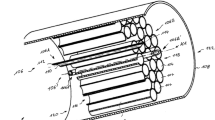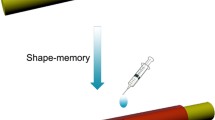Abstract
Guided tissue regeneration is a new approach in the reconstructive surgery of peripheral nerves. Artificial conduits can be constructed from biodegradable polymers. Lactic/caproic acid copolymers and polyphospazenes are biocompatible materials with a slow resorption rate. Conduits made from either poly-[l-lactide-co-6-caprolatone] or poly-[bis-(ethylalanate)-phosphazene] were assessed for use as guides for nerve regeneration in experimental animals. Under general anesthesia and by using a microsurgery technique both sciatic nerves were exposed in 2 groups of 9 Wistar rats. On the right side, a 10 mm segment of the nerve was removed, and the defect was then repaired using a conduit. On the left side, the same defect was bridged using as an autograft the nerve segment, which had been removed from the right sciatic nerve. Histological and electron microscopy investigations were performed after 30, 90 and 180 days and showed the gradual degradation of both types of conduits without any evidence of local toxicity. The regeneration of the nerve fibers in the lumen was not significantly different from that shown by the autologous grafts. Likewise, no differences were found at 180 days in the functional recovery of the nerve (evoked muscle action potential). Both conduits were found to be effective for guided nerve regeneration. Poly-[l-lactide-co-6-caprolactone] tubes were easier to insert, while polyphosphazene conduits allowed the use of neurite-promoting factors.
Résumé
La régénération tissulaire guidée est une nouvelle perspective dans la reconstruction des nerfs périphériques. Des conduits artificiels peuvent être obtenus avec des polymères biodégradables. Nous avons évalué dans un modèle expérimental deux types de polymères le poly-[1-lactide-co-6-caprolactone] et le poly-[bis-(etilalanate)- phosphazene]. Cette expérimentation a été, conduite sous anesthésie générale au niveau du nerf sciatique de 9 rats Wistar, un segment de 10 mm de nerf a été réséqué et du côté droit la reconstruction a été faite en utilisant une polymère du côté gauche, la réparation a été faite avec une autogreffe avec le segment réséqué du côté opposé. Une étude histologique et par microscopie électronique a été faite à 30, 90 et 180 jours. Il n’y a pas eu de toxicité locale des conduits en polymère. La régénération des fibres nerveuses dans les deux types de conduits ne fut pas différente de celle observée avec les autogreffes. Les deux types de conduits peuvent être considérés comme efficaces pour guider la régénération nerveuse. Le tube en polycaprolactone est plus maniable alors que celui en polyphosphazene peut contenir des facteurs favorisant la croissance axonale.
Similar content being viewed by others
Author information
Authors and Affiliations
Additional information
Accepted: 15 March 2000
Rights and permissions
About this article
Cite this article
Nicoli Aldini, N., Fini, M., Rocca, M. et al. Guided regeneration with resorbable conduits in experimental peripheral nerve injuries. International Orthopaedics SICOT 24, 121–125 (2000). https://doi.org/10.1007/s002640000142
Issue Date:
DOI: https://doi.org/10.1007/s002640000142




